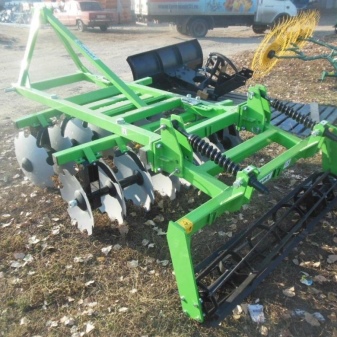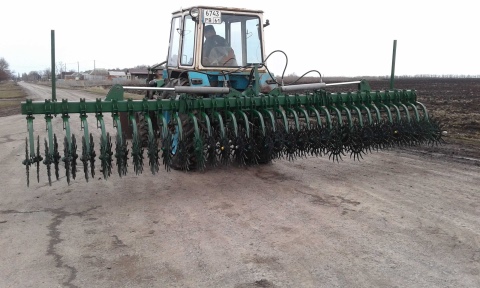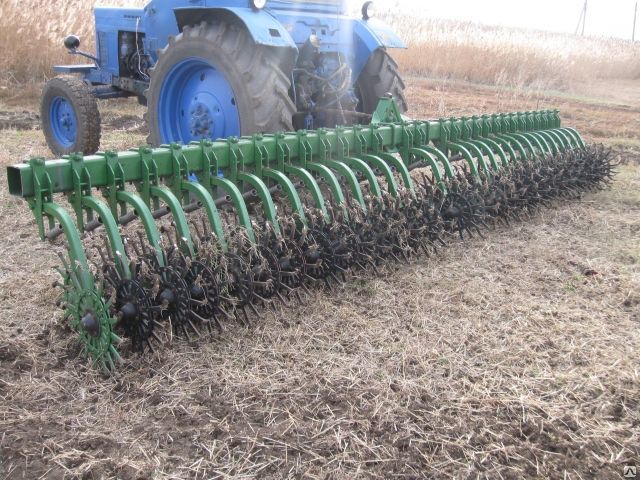Views
The harrow for a walk-behind tractor is of several types: tooth, needle, disc and rotary (rotary).
Dental model
It is the simplest type of equipment and is a smaller copy of the classic harrow that tractors are equipped with. Structurally, it is made in the form of a wedge-shaped or rectangular frame, with metal teeth from 25 to 40 mm in length placed on it. The location of the teeth on the frame is different, however, the most common option is zigzag, while the teeth themselves can have both circular and rectangular cross-sections.
The tine harrow is able to loosen the soil by 10-14 cm, which contributes to the normalization of air exchange and regulates the water balance.
The advantage of the view is the simplicity of the design, the absence of complex assemblies and the ability to make the device with your own hands.
The main working characteristics of the tooth model can be considered on the example of the widespread two-track harrow BN-1, which is designed specifically for the Neva walk-behind tractor. Using this model, loosening is performed, large clods of soil formed as a result of plowing are crushed and leveling of the topsoil is performed.
The depth of soil processing varies from 3 to 10 cm, and the productivity is 0.2-0.5 hectares / hour. The grip width is regulated with a special handle and ranges from 60 to 100 cm. The dimensions of the model are 72x67x51 cm, weight - 17 kg, and the optimal harrowing speed is 4 km / h.
Needle model
Its design is somewhat reminiscent of a tooth, however, differs from it in that instead of the teeth welded to the frame, replaceable arcuate perforated pins are installed. This harrow allows you to cultivate stubble and is used to level the soil, which prevents it from drying out.
As an example of a needle model, you can consider the harrow for the Zubr walk-behind tractor. The grip width of this device is 1 m, and the loosening depth reaches 14 cm.
The device is attached to the walk-behind tractor by means of a rigid hitch with an adjustment mechanism. The harrow weighs 30 kg.
Disk model
It is presented in the form of spherical discs, which have a smooth or perforated design. Using a harrow with perforated discs gives the best processing results, however, it requires constant cleaning of the working surface during harrowing.
The discs are attached to the frame at a different angle of inclination, which in each case is set by the operator of the walk-behind tractor and depends on the type of soil and its condition. The principle of operation of disc models is quite simple and is as follows: while the walk-behind tractor is moving, the harrow discs cut off the top layer of the earth and grind it. In this case, the weeds are turned inside out and cut.
Attaching the disc harrow to the walk-behind tractor can be done in front and behind the unit and depends on the model of the walk-behind tractor and the type of attachment.
The range of disk devices is wide enough, so it would be unfair to take any one model as a reference. In the line of disk devices, there are mainly quite powerful devices. The largest of them have a working width of up to 140 cm, they can go 20 cm into the ground and weigh up to 70 kg.
Rotary or rotary models
They belong to the active class of attachments. Their difference from the three previous passive models is that they are not attached to the walk-behind tractor by means of a hitch, but are installed on the unit instead of wheels.The working part of such devices is presented in the form of pointed plates located on disks, which are installed at a certain angle. It is the plates that are the working mechanism and carry out the soil cultivation.
The depth of entry into the ground for rotary models is quite small and is only 7 cm, which is quite enough for cultivating the land immediately after harvesting grain crops. The greatest efficiency can be achieved when installing rotary models on walk-behind tractors with gearboxes.
In addition to the introduction of seeds, using a rotary harrow, mineral fertilizers are injected to the desired depth.
As an example, we can consider a Russian-made rotary harrow for the Neva walk-behind tractor. The device is capable of effectively leveling the soil after plowing and adding mineral additives to a depth of 5 to 7 cm.
The harrowing width of such a device is 1.4 m with a length of one section of 70 cm and a harrow diameter of 35 cm. The depth of loosening is somewhat greater than that of other models of this type and reaches 10 cm. The weight of one section is 9 kg.
2 Specific types and models that have worked well
In addition to the general characteristics that certain harrows have, there are also design features that a particular manufacturer adheres to. In addition, in conditions of market competition, each manufacturer tries to invent and implement various know-hows for their products.
2.1 BDF
Harrow BDF is a hinged structure operating at speeds up to 12 km / h.
Disc harrow BDF
Can handle up to 7 meters wide soil. It has two rows with discs, which in conditions of soil moisture up to 27% allows you to increase the speed of work up to 14 km / h.
2.2 Dominant
The Dominant hoe is adapted for use in our climatic conditions. It copes well with very dense bushes, which is sometimes beyond the control of all other types of harrows. It can work at higher speeds up to 14 km / h.
2.3 Demeter and Degelman
Demeter can also handle soils with high levels of moisture and dryness (like models of paper harrows). The rotating disc of this device allows you to penetrate the soil to a depth of 14-20 cm in one pass.
Degelman - like the domestic spring Pobeda, has a length of 14 m, a width of 4 m, and dimensions for transportation up to 20 m.
2.4 Other varieties
There are improved spring harrows, BDT 3, BS, M16, BG, Veles and others. Each of them differs in its design features, type of teeth, frame, etc. In their favor, there are several "FOR":
- increased indicators of land cultivation (in terms of depth, working width, etc.);
- the possibility of developing higher working speeds compared to usual;
- long service life due to reinforced main structures;
- availability of any additional equipment, etc.
When choosing such a device for your tasks, you should always carefully study its features, and choose exactly the option that is suitable for a specific type of soil.
Device and principle of operation
The rotary harrow-hoe consists of a supporting frame with attached sun-type wheels, which have a diameter of up to 60 cm and are located in several blocks on a spring-loaded swing arm. The mobility of the lever is provided by a special spring, which, due to its extension, acts on the lever itself and the wheels located on it, forcing the entire structure to exert pressure on the soil. The beams-needles that make up the wheels are made of spring steel, screwed or riveted to the disc, and in case of breakage they are dismantled and easily replaced with new ones. Needle discs, in turn, have a movable structure, and can change the angle of attack from 0 to 12 degrees.Rotary harrows-hoes are available in different sizes and can have working widths of 6, 9 and even 12 meters.


By the type of attachment to the tractor, the harrow can be trailed or mounted. The hinged mounts are mostly lighter models, while the heavyweights are mounted like a trailer. In both cases, as soon as the tractor starts to move, the harrow wheels also begin to spin and sink into the ground by 3-6 cm. Due to their sun-like structure, the rays of the wheels pierce the hard soil crust and thereby contribute to the unhindered penetration of air into the upper fertile soil layer. Thanks to this, the nitrogen present in the air penetrates into the ground and is actively absorbed by the roots of plants. This makes it possible to partially abandon the use of nitrogen-containing fertilizers during the period of seed germination. The cultivation of crops using the needle discs of rotary harrows-hoes is identical to the application of nitrogen at a concentration of 100 kg / ha.
A feature of using hoe harrows is the possibility of a delicate, but at the same time effective impact on the soil. To do this, the discs are installed so that when the needles are immersed in the ground, their convex side looks in the direction opposite to the direction of movement. It is precisely the gentle cultivation of the soil that distinguishes the rotary needle harrows-hoes from the tooth harrows, which are no longer used when the first shoots appear.

Advantages and disadvantages
Like any type of agricultural machinery, rotary hoe harrows have their own strengths and weaknesses.
The pluses include a very low percentage of plant damage during harrowing, which barely reaches 0.8%. By the way, in the above-mentioned dental models, this figure reaches 15%. In addition, the devices can be used at an early stage of weed control, which is not possible with other types of harrows. Due to this, the rotary needle models are indispensable for the processing of corn fields, which are at the stage when 2-3 leaves have already appeared on the shoots. Harrowing in this case is carried out at a speed of 15 km / h, which allows you to get rid of large areas of weeds in a short time.
Judging by the reviews of experienced, farmers, harrows of this type do not have any special complaints, with the exception of the too high cost of some specimens. For example, the price of the BMR-6 unit is 395,000, and the cost of the BMR-12 PS (BIG) model even reaches 990,000 rubles.








































